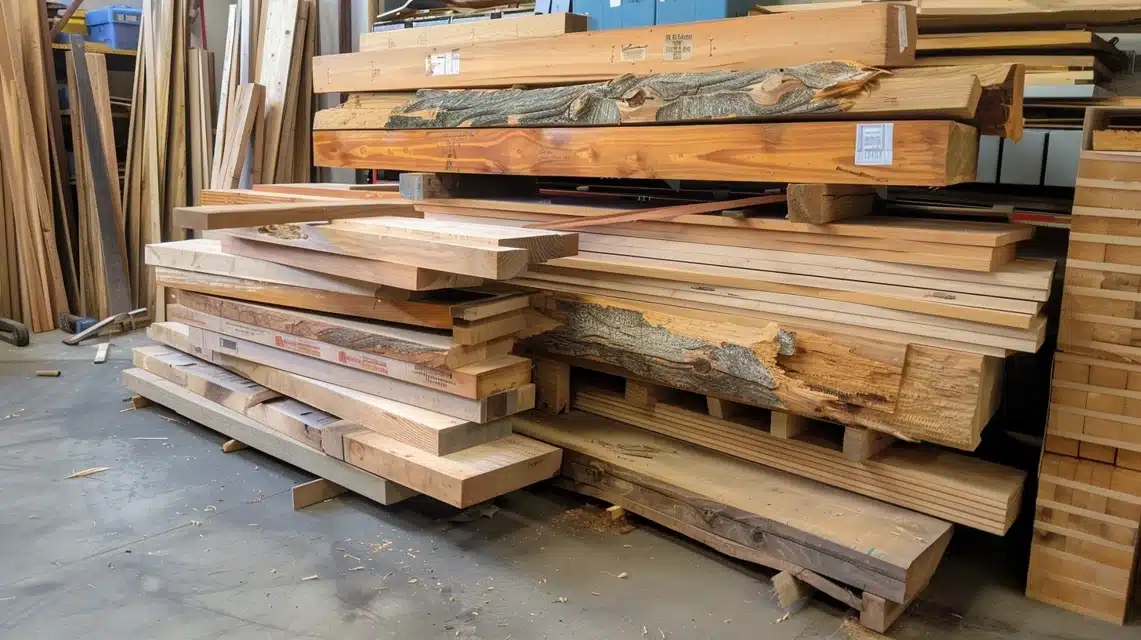A Guide to Common Lumber Sizes Used in Deck
Are you curious about the common lumber sizes for your next project?
Different lumber sizes create a safe, stable structure, from support beams to posts.
While lumber names like “2×8” or “4×6” might seem simple, understanding their actual measurements and best uses helps make better building choices.
This guide looks at five main types of lumber used in deck building, their real sizes after processing, and how they work together.
We’ll also examine why lumber measurements differ from their names and how to pick the right size for each part.
Basics of Lumber Sizing
What are Nominal Lumber Sizes?
The name of lumber pieces often doesn’t match their actual size. The size we call lumber, such as “2×8” or “4×6,” refers to the rough size before the wood is processed.
These names come from the initial wood cut at lumber mills, but the final product is smaller.
The Difference Between Nominal and Actual Sizes
Let’s look at real examples from deck building:
- A “2×8” board actually measures 1.5 x 7.5 inches
- A “4×8” beam comes out as 3.5 x 7.5 inches
- A “2×6” piece ends up as 1.5 x 5.5 inches
- A “4×6” post measures 3.5 x 5.5 inches
- A “4×4” becomes 3.5 x 3.5 inches
Why Do Discrepancies Exist?
The size difference happens because of how lumber gets made:
- Mills start with rough-cut pieces at the stated size
- The wood receives pressure-treated for outdoor use
- The pieces go through planing to make them smooth
- Each step removes a bit more material
- The result is a smaller but finished board
The final size might vary slightly between different mills. For example, based on the mill’s specific methods, a 2×8 board’s width might range from 7.25 to 7.75 inches.
5 Most Commonly Used Lumbar Sizes in Decks
2×8 Lumber: The Backbone of Decks
The 2×8 board stands as a basic yet essential part of deck building. While its name suggests it’s 2 inches by 8 inches, the size differs after processing.
Let’s look at what makes this lumber so important for deck construction.
Dimensions: Milled to Approximately 1.5 Inches by 7.5 Inches
When the mill processes these boards, they start as true 2×8 pieces. However, after milling, the final measurements reach about 1.5 inches by 7.5 inches.
Depending on the specific mill’s process, some boards might measure slightly differently—between 7.25 and 7.75 inches in width.
Typical Uses: Joists and Rim Joists
2×8 lumber serves as the main support structure in deck framing. You’ll find these boards used as:
- Deck joists that run across the frame
- Rim joists that form the outer edge
- Ledger boards that connect the deck to buildings
Code Compliance Considerations for Spanning Distances
The placement of 2×8 boards must follow specific safety rules:
- The distance between supports can’t exceed certain limits
- If the span is too long, the deck will become too flexible
- Building codes require proper beam support at set points
- Getting permits requires following these spacing guidelines
4×8 Lumber: Essential for Beam Support
Building a strong deck requires careful selection of support beams. The 4×8 lumber perfectly fills this role and offers key benefits for deck structure.
Dimensions: Milled to 3.5 Inches by 7.5 Inches
Like other lumber types, 4×8 boards start larger at the mill as true 4-inch by 8-inch pieces.
After processing, they measure:
- Width: 3.5 inches
- Height: 7.5 inches.
These boards go through two key steps:
- First, they’re cut to size
- Then, they receive pressure treatment for durability
Primary Use: Beams for Added Structural Support
The main purpose of 4×8 lumber is to serve as support beams. These thick boards create a strong foundation that helps distribute the deck’s weight throughout the structure.
Ideal for Low Decks Where Space Is Limited
4×8 beams work well in tight spaces, particularly in low deck designs. When you have at least 16 inches of space, you can:
- Place a 4×8 beam
- Add a 2×8 joist on top
- Create a stable support system without wasting space
2×6 Lumber: Versatile and Compact
The 2×6 lumber plays a specific but important role in deck building, particularly when adding stability between larger boards.
Dimensions: Approximately 1.5 Inches by 5.5 Inches
After milling and processing, 2×6 lumber becomes more compact than its bigger cousins. These boards offer:
- Width: 1.5 inches
- Height: 5.5 inches
Common Uses: Blocking Between Joists
The main job of 2×6 lumber in deck building is pressure blocking. These boards fit between deck joists to:
- Add stability to the frame
- Keep the structure firm
- Support the overall deck design
Advantages of Blocking Over 2×8 to Prevent Issues with Deck Boards
Using 2×6 lumber for blocking instead of 2×8 brings clear benefits:
- Sits lower than the joist height by a few inches
- No need to cut down each blocking piece
- It makes deck board installation simpler
- Helps workers maintain good progress during construction
- It prevents problems when laying the top boards
4×6 Lumber: A Solid Choice for Posts and Beams
When building needs call for strong support pieces, 4×6 lumber is a reliable option for deck construction.
Dimensions: Roughly 3.5 Inches by 5.5 Inches
The finished size of 4×6 lumber after processing measures:
- Width: 3.5 inches
- Height: 5.5 inches
Common Applications: Posts and Vertical Elements
4×6 lumber serves multiple purposes in deck building:
- Works well as support posts
- Functions as strong beams
- Serves as vertical supports for skirting
- Helps join different deck sections
- Adds support when placed on top of walls
Comparison with 4×4: Offers More Strength and Less Cracking
4×6 lumber brings several benefits compared to smaller sizes:
- Greater strength as a building material
- Less likely to split or crack
- More stable when used as posts
- Better suited for structural needs
- Works well for connecting different deck parts
4×4 Lumber: Lightweight Support for Smaller Structures
The 4×4 lumber fills a specific role in deck construction, offering support options for less demanding parts of the structure.
Dimensions: Approximately 3.5 Inches Square
After milling, 4×4 lumber comes in an even square shape:
- Width: 3.5 inches
- Height: 3.5 inches
- This square design makes it useful for certain building needs.
Common Uses: Light-Duty Posts and Skirting Support
4×4 lumber works well in several situations:
- Supporting deck skirting
- Adding spacing where needed
- Serving as light vertical supports
- Filling gaps between sections
- Helping with smaller building tasks
Limitations Compared to 4×6 and Situations Where It’s Best Suited
Understanding when to use 4×4 matters for good construction:
- Less structural strength than 4×6
- Better for light-duty tasks
- Works for simple vertical supports
- Suits basic framing needs
- Good for non-main support areas
Lumber Types and Grades
Lumber Grades
Lumber grades help classify wood quality based on strength, appearance, and defect level.
Softwood lumber, commonly used in construction, is graded based on structural soundness, while hardwood lumber is graded based on appearance due to its decorative use.
Common Softwood Grades: No. 1 vs. No. 2
No. 1 Common
This grade has fewer and smaller knots and imperfections, offering greater structural integrity and strength.
It’s generally chosen for load-bearing applications and projects where durability is paramount.
No. 2 Common
This grade includes more visible knots and imperfections, which can impact its structural strength.
No. 2 Common is often used in non-load-bearing applications or areas where appearance isn’t the primary concern.
Impact of Defects on Lumber Selection
Defects like knots, splits, and warping affect the strength and appearance of lumber.
Builders choose grades based on the project’s structural requirements; for instance, a deck’s support beams would need No. 1 Common or better, while a less critical structure could use No. 2 Common.
Higher grades are often selected for decorative or exposed wood to ensure a smooth, attractive finish without visible flaws.
Summing Up
Each piece, from the 2×8 joists to the 4×4 support posts, contributes to the strong structure.
Understanding the difference between listed and actual sizes helps builders plan better and choose materials wisely.
Knowing which lumber best meets specific needs—structural support, blocking, or finishing touches—you can build longer decks that meet all safety requirements.
Remember always to check local building codes and get expert advice when needed.
Frequently Asked Questions
What are Common Rough Cut Lumber Sizes?
Common rough cut lumber sizes include 1×6, 2×4, 2×6, 2×8, 4×4, and 4×8 inches. These sizes refer to the rough dimensions before planing reduces them slightly.
Is it Cheaper to Buy Rough Cut Lumber?
Yes, rough-cut lumber is often cheaper since it hasn’t undergone additional milling or smoothing processes, making it a cost-effective option for DIY and rustic projects.








